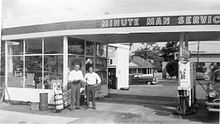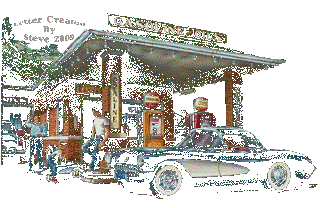Service stations
A service station or "servo" is the terminology predominantly used in Australia and New Zealand. In Australia, a servo is commonly used to explain any facility where you can refuel your car.
In New Zealand a filling station is often referred to as a service station, garage, or petrol station, even though the filling station may not offer mechanical repairs or assistance with dispensing fuel. Levels of service available include full service, for which assistance in dispensing fuel is offered, as well as offers to check tyre pressure or clean vehicle windscreens. This type of service is becoming uncommon in New Zealand, particularly Auckland. Further south of Auckland, many filling stations offer full service. There is also help service or assisted service, for which customers must request assistance before it is given, and self-service, for which no assistance is available.
In the UK, a 'service station' refers to much larger facilities, usually attached to motorways (see rest area) or major truck routes, which provide food outlets, large parking areas, and often other services such as hotels, arcade games, and shops in addition to 24-hour fuel supplies and a higher standard of restrooms. Fuel is typically more expensive from these outlets due to their premium locations. UK service stations do not usually repair automobiles.
In the U.S., a filling station that also offers services such as oil changes and mechanical repairs to automobiles is called a service station. Until the 1970's the vast majority of gas stations were service stations; now only a minority are. This kind of business provided the name for the U.S. comic strip Gasoline Alley, where a number of the characters worked. List of Gas stations. This arrangement occurs on many toll roads and some interstate freeways and is called an oasis, service plaza, or truck stop. In many cases, these centers might have a food court or cafeteria. In the U.S., Pilot Flying J and TravelAmerica are two of the most common full-service chains.
Often, the state government maintains public rest areas directly connected to freeways, but does not rent out space to private businesses, as this is specifically prohibited by law via the Interstate Highway Act of 1956 which created the national Interstate Highway System, except sites on freeways built before January 1, 1960, and toll highways that are self-supporting but have Interstate designation, under a grandfather clause. As a result, such areas often provide only minimal services such as restrooms and vending machines.
Private entrepreneurs develop additional facilities, such as restaurants, gas stations, and motels in clusters on private land adjacent to major interchanges. Because these facilities are not directly connected to the freeway, they usually have huge signs on poles high enough to be visible by motorists in time to exit from the freeway. Sometimes, the state also posts small official signs (normally blue) indicating what types of gas stations, restaurants, and hotels are available at an upcoming exit; businesses may add their logos to these signs for a fee.
Fuel prices in North America
In Canada and the United States, federal, state or provincial, and local sales taxes are usually included in the price, although tax details are often posted at the pump and some stations may provide details on sales receipts. Gas taxes are often ring-fenced to fund transportation projects such as the maintenance of existing roads and construction of new ones.
In the United States, the states of California and Hawaii typically have the highest gasoline prices, while the lowest prices are usually found in oil producing states like Oklahoma and Texas. In Canada, prices are typically highest in the provinces of British Columbia and Quebec, and the lowest in the oil-producing province of Alberta. The provinces of Prince Edward Island (PEI), Newfoundland and Labrador, New Brunswick, and Nova Scotia have instituted gasoline price regulation, which is intended to protect small rural gas stations from low profits due to low sales volume.
Individual gas stations in the United States have little if any control over gasoline prices. The wholesale price of gasoline is determined according to area by oil companies which supply the gasoline, and their prices are largely determined by the world markets for oil. Individual gas stations are unlikely to sell gasoline at a loss, and the margin—typically between 7 and 11 cents a U.S. gallon—that they make from gasoline sales is limited by competitive pressures: a gas station which charges more than others will lose customers to them. Most gas stations try to compensate by selling higher-margin food products in their convenience stores.
Even with oil market fluctuations, prices for gasoline in the United States are among the lowest in the industrialized world; this is principally due to lower taxes. While the sales price of gasoline in Europe is more than twice that in the United States, the price of gas excluding taxes is nearly identical in the two areas. Some Canadians and Mexicans in communities close to the U.S. border drive into the United States to purchase cheaper gasoline.
Due to heavy fluctuations of gasoline price in the United States, some gas stations offer their customers the option to buy and store gas for future uses, such as the service provided by First Fuel Bank.
In order to save money, some consumers in Canada and the United States inform each other about low and high prices through the use of gasoline price websites. Such websites allow users to share prices advertised at filling stations with each other by posting them to a central server. Consumers then may check the prices listed in their geographic area in order to select the station with the lowest price available at the time. Some television and radio stations also compile pricing information via viewer and listener reports of pricing or reporter observations and present it as a regular segment of their newscasts, usually before or after traffic reports. These price observations must usually be made by reading the pricing signs outside stations, as many companies do not give their prices by telephone due to competitive concerns. In Canada it is against federal law to provide any gas pricing from a gas station via phone. It is a criminal offence to have written or verbal arrangements with competitors, suppliers or customers for:
- fixing prices and exchanging information on prices or cost (including discounts and rebates),
- limiting or restraining competition unduly,
- engaging in misleading or deceptive practices.
Source: Internet






























No comments:
Post a Comment